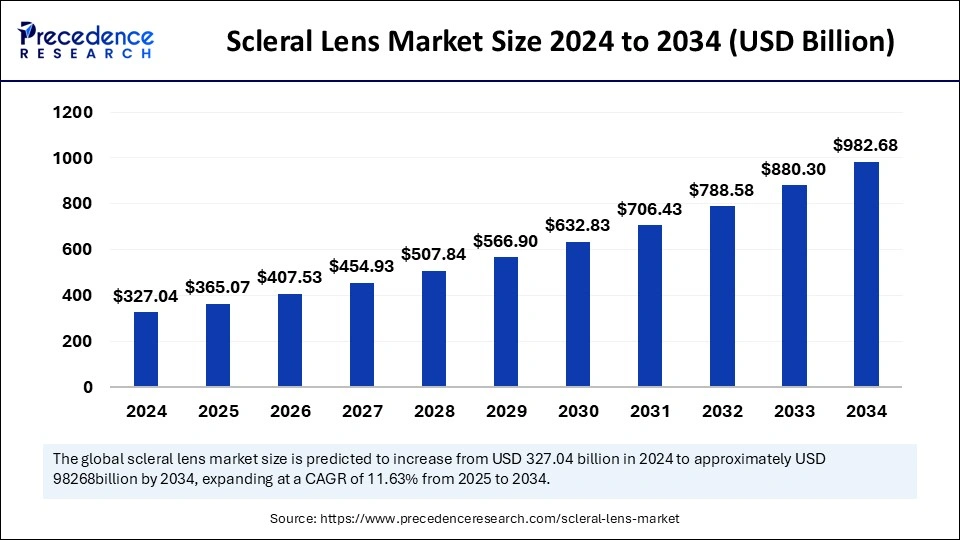Scleral lens market will expand from USD 327.04 billion in 2024 to USD 982.68 billion by 2034, fueled by increasing adoption in vision correction, at a CAGR of 11.63%

Scleral Lens Market Key Takeaways
-
In 2024, North America dominated the scleral lens market with a 41% share, while Asia Pacific is expected to grow at the fastest CAGR during the forecast period.
-
Corneo-scleral and semi-scleral lenses led the market by type in 2024, with mini-scleral lenses anticipated to expand at the highest growth rate.
-
The irregular cornea segment captured the largest market share by application in 2024, while the ocular surface disease segment is projected to grow the fastest.
-
Eye clinics generated the highest market share by end user in 2024, while hospitals are expected to register the fastest growth over the forecast period.
Scleral Lens Market Overview
The Scleral Lens Market is experiencing notable growth driven by advancements in lens design, material science, and digital imaging technologies. Scleral lenses are specialized contact lenses designed to address complex corneal conditions by creating a fluid-filled space between the cornea and the lens. This space protects the cornea, hydrates the ocular surface, and provides clear, stable vision, making scleral lenses an ideal choice for patients with irregular corneas, severe dry eye syndrome, and other ocular disorders.
Technological innovations have significantly improved the design and performance of scleral lenses, resulting in enhanced comfort, oxygen permeability, and better fit for patients. The integration of advanced corneal topography and OCT imaging has enabled eye care practitioners to achieve more precise and customized fits, reducing the risk of complications and improving patient satisfaction. These advancements have expanded the application of scleral lenses beyond traditional indications, contributing to increased adoption and market growth.
Scleral Lens Market Drivers
The integration of advanced imaging and digital technologies is a key driver of the scleral lens market. Modern corneal topography and OCT systems enable eye care professionals to map the corneal surface with high precision, allowing for the design of customized scleral lenses that provide superior visual outcomes and comfort.
The development of innovative lens materials with enhanced oxygen permeability is another factor driving market growth. Advanced gas-permeable materials ensure that the cornea receives adequate oxygen, reducing the risk of corneal hypoxia and increasing patient comfort during prolonged lens wear. These technological advancements have improved the overall safety and efficacy of scleral lenses, leading to higher adoption rates among patients with complex ocular conditions.
Market Opportunities
The adoption of digital lens design and manufacturing technologies presents significant opportunities for the scleral lens market. The use of computer-aided design (CAD) and computer-aided manufacturing (CAM) technologies allows for the production of highly customized scleral lenses that offer better fit, comfort, and visual acuity. Digital manufacturing processes also enable faster production times and greater consistency in lens quality, addressing the growing demand for personalized eye care solutions.
Another promising opportunity lies in the expansion of scleral lens applications in pediatric eye care. Children with congenital corneal abnormalities or severe dry eye conditions can benefit significantly from the protective and hydrating properties of scleral lenses. As awareness about the advantages of scleral lenses in managing pediatric ocular disorders grows, the market is expected to witness increased adoption in this segment.
Market Challenges
The complexity of fitting and patient adaptation remains a challenge for the scleral lens market. Achieving an optimal fit requires specialized training and expertise, and the fitting process can be time-consuming for both practitioners and patients. Additionally, patients may experience an adjustment period before achieving optimal comfort and visual outcomes with scleral lenses, posing a barrier to widespread adoption.
Regional Insights
North America leads the scleral lens market due to the widespread adoption of advanced eye care technologies and the presence of established manufacturers specializing in custom contact lenses. The United States is a major contributor to market growth, supported by the availability of cutting-edge imaging systems and a growing patient population with complex corneal conditions.
Europe is experiencing steady growth in the scleral lens market, driven by increased awareness about the benefits of scleral lenses and advancements in eye care technologies. Countries such as Germany, France, and the United Kingdom are witnessing rising demand for customized scleral lenses to address diverse ocular conditions.
Asia Pacific is emerging as a high-growth region for the scleral lens market due to the rising prevalence of corneal disorders and expanding healthcare infrastructure. Countries like China, India, and Japan are investing in improving access to advanced eye care services, contributing to increased adoption of scleral lenses in the region.
Recent Developments
Recent developments in the scleral lens market include the introduction of hybrid lens technologies that combine the benefits of scleral lenses with the ease of fitting associated with traditional contact lenses. Manufacturers are also focusing on enhancing the oxygen permeability, comfort, and stability of scleral lenses to meet the evolving needs of patients with complex ocular conditions.
Scleral Lens Market Companies
- ABB Optical Group
- Alden Optical Laboratories
- Art Optical Contact Lens Inc.
- Bausch Health Companies Inc.
- Blanchard Lab
- Boston Sight
- Essilor
- SynergEyes
- TruForm Optics Inc.
- Valley Contax
- Visionary Optics
Segments Covered in the Report
By Type
- Corneo-Scleral Lenses and Semi-Scleral Lenses
- Mini-Scleral Lenses
- Full Scleral Lenses
By Application
- Irregular Cornea
- Ocular Surface Disease
- Refractive Error
- Other Applications
By End-User
- Hospitals
- Eye Clinics
- Other End Users
By Geography
- North America
- Europe
- Asia Pacific
- Latin America
- Middle East and Africa
Ready for more? Dive into the full experience on our website!
